Everyone wants their property to look beautiful. Green spaces, of course, are pleasing to the eye, but, you see, the bright spots of flower beds lift your spirits even more, especially on cloudy days.
If you want your plot to delight you with bright, rich colors for many months, plant flower crops on its territory.
And spring is the right time for this.
Methods for spring planting flowers
There are three landing options flower crops V open ground:
1. seedlings – seedling method;
2. with seeds – without seedlings;
3. tubers, rhizomes - planting as a result of dividing perennials.
Seedling method
Of all the options listed, seedlings are the most expensive and time-consuming, but the results are worth it. The advantages of this method are that plants bloom earlier and last longer. There are flowers that can only be grown by seedlings, in particular crops with small seeds: viola, viola, etc.
Seeds are sown for seedlings from January to April, the specific period depends on the length of the growing season of a particular species. Sowing dates are usually written on bags of seeds.
To grow seedlings, use any universal soil mixture, either forest or garden soil, which is first disinfected from weeds and pests. All seedling containers are also disinfected before use.
Seeds are sown in shallow boxes and covered with film or glass. Germination occurs at a temperature of 20-24°C; they do not need lighting at this stage. From time to time, the crops are watered and ventilated.
When seedlings appear, the box is moved to a bright place; in some cases, additional lamp lighting may be needed. The temperature at this stage of development is 16-18°C.
When the first true leaves appear, the seedlings are planted (dive) into small containers (cups) for better development root system. It is planted in open ground when the threat of frost has passed, around mid-May.
Seedless method
Those who want to create a flower garden on their site with a minimum of effort and expense choose the seedless method. I threw the seed into the ground, watered it, it grew, and no problems with the seedlings.
However, only frost-resistant plants can be grown this way. And some crops do not tolerate transplants at all, so they are grown exclusively without seedlings. For example: cosmos, cornflowers, gypsophila, nasturtium, mignonette and others.
The exact timing of sowing in open ground primarily depends on the local climate and current weather.
The timing is also affected by the length of the growing season. For example, cold-resistant crops with a long growing season are sown early (approximately mid-April). A to heat-loving crops with a short growing season, late sowing is used (approximately from mid-May to early autumn).
Sow the seeds in soil prepared in advance. Grooves are made for small seeds, and nests are made for large ones. The depth of planting the seed should be equal to the sum of 2-3 of its diameters. And the distance between the seeds is at least 1 cm.
Then the crops are thinned several times. The first time - when the first true leaves appear, 5 cm are left between the seedlings. They are thinned out again 10 days after the first, but the distance is left longer - between small plants 10 cm, between large ones 30-40 cm.

The start is quickly approaching planting season in the garden...In one ofpublications we talked about, now is the timetalk in more detail about planting in open ground. What does this include?
- sowing seeds in open ground
- planting seedlings (which you grew yourself or bought in a store)
- replanting and dividing perennials
Which ones exist? What are the dates for planting flowers?
In spring, from mid-April to late May- the most suitable period for planting most plants, including those blooming in autumn and
. they are planted in the ground with seedlings or seeds, and perennials are often planted in small “divisions” (this way they will take root and bloom faster). LandingIt is better to postpone the most heat-loving flowers until the end of spring frosts.When planting in spring, the main danger is that the plants dry out, so at first they need to be provided sufficient watering
.
In summer Plant all plants with a closed root system. During summer planting, soJust like in the spring, it is important not to dry out the plants during transplantation and establishment.
Autumn the planting season begins during mass leaf fall andends with the onset of frost. This is a good time to plant And blooming in spring. In early autumn they are planted on permanent place perennials, and wintering ones - when the average dailytemperature 8-9 degrees (second half of September). At autumn planting The greatest danger is overwatering: the accumulation of large amounts of water in tissues reduces winter hardiness. There is also a danger of plant roots freezing when transplanting during frosts.
Perennials with summer flowering can be replanted in both spring and fall. In anyIn this case, it is advisable to avoid replanting plants during flowering.
Planting seeds in open ground
Of course, if you want to achieve flowering as early as possible, then without you not enough. Many of the plants listed below, sown directly into the ground,will bloom quite late (for example, marigolds, annual dahlias, etc.). Eatcompromise option: sow in the ground, but under film, at the end of April.
Cold-hardy annuals you can sow in the end of Aprildirectly into the ground as soon as the soil is ready. In this way you can sow:
agrostemma, adonis, calendula, cornflower, bindweed, annual chrysanthemum, carnationChinese, Eschscholzia, Gaillardia, Godetia, Clarkia, sunflower, hibiscusannual, limnanthes, toadflax, malcolmia, matricaria, nicandra, nigella, poppy, skerda, phacelia.
In the first half of May aster, bidens, anhusa, delphinium can be sownAjax, sweet pea, iberis, coreopsis, cosmos, kochia, lavatera, flaxgrandiflora, malopa, matthiola, mignonette, annual rudbeckia, gum, Drummond's phlox.
In May, but with the expectation that the seedlings will not fall under the last frost, you can sow in the ground heat-loving annuals: morning glory, decorative beans,, nasturtium, amaranth, arctotis, marigolds, ursinia, mesembryanthemum,zinnia, salpiglossis.
Sowing seeds of perennial flowers
Perennials, having relatively large seeds and giving quick and friendly shoots, you can also pre-sow orpermanent place:
- for ridges and borders: yarrow, mantle, columbine, centranthus,bells, coreopsis, echinacea, gaillardia, liatris, lupine, lychnis, physalis,cyanosis, rudbeckia, sedum, cidalcea, evening primrose, carnation, monarda, gravilat, mountain cornflower, pyrethrum, delphinium, lush sage
- : alyssum, chickweed, rhizome (arabis), bluebells, carnations, iberis, flax, aubretia (aubrieta), creeping gypsophila, soapwort, alpine aster, chickweed.
ADVICE: it is undesirable to sow perennials very early, since in the firstDuring the first year of life, they only form a rosette of leaves or a bush, but do not bloom. If the plants are sown too early, they begin to bloom in the fall, do not have time to prepare for winter, and may die.
Seeds biennials (stock rose, daisies, lacfiol, Turkish carnation,foxglove, bellflower (“cup and saucer”), matthiola, pansies(viola), etc.) are usually sown late May – June. It is best to sow them temporarily in separately allocated places in the garden, and then transplant them to a permanent place where they will bloom for a long time. next year. This is described in the article "".
The seeds of most of these flowers are not large, the shoots are small and delicate, thereforeit is important to shade them in the first days, for example, with lutrasil, and in dry weather -water daily. Daisies, viola, forget-me-nots, Turkish cloves They form a powerful fibrous root system and are not afraid of transplantation. Therefore, they are usually sown quite densely, and then planted at a distance of 7x7 cm.
Please note: it is not always possible to obtain seedlings from viols and grow from itseedlings The fact is that it requires damp, cool weather to germinate.Therefore, in hot weather, it is better to sow its seeds in boxes and place them in the shadehouses on the north side or in.
Soil preparation
To get great blooms, it is important to before planting the plants in the soil. Prepare the planting area in advance, at least a few days in advance, so that the soil settles a little. It must be loosened and fertilizer added (in the proportions and quantities required for the soil). The soil is also improved by filling it with sawdust, rotted manure, compost, sand, lowland peat (or rotted high peat), mineral fertilizers(a tablespoon of granular NPK per square meter).
Cultivated soil has a “sausage property”: a “sausage” made from moist soil must be bent in your hands - it should not crumble, but only crack slightly when bent.
Sowing also gives good results, but this must be done in advance, a season earlier than the intended planting.
More on this topic:
Planting seedlings It is better on cloudy days or in the evening, after thoroughly watering the boxes or pots with plants. , and if the soil is loose, then directly with your hands, you need to make a hole, place the roots in it (if the seedlings were grown in - then right with them), sprinkle the soil and squeeze it well around the plant.
Landing in the ground
Already in the first ten days of May you can plant Shabot cloves, sweet peas, leftover, cineraria - these crops can tolerate light frosts (up to -4°C) without shelter.
IN end of the second decade you can plant ageratum, snapdragon, aster, verbena, gaillardia, gatsaniya, Chinese cloves, ornamental cabbage, cleome, kochia, craspedia, lavatera, petunia, purslane, rudbeckia, salvia, sweet tobacco, Drummond's phlox and other annuals.
Distance between plants depends on the habit of the crop and the type of planting:
- low borders (lobelia, alyssum, Drummond phlox, purslane), as well ascarpet plantings (from evergreen begonia, cineraria, santolina) - planted densely, at a distance of 10-15 cm
- most plants with bushes average size, placed every 20-25 cm
- large-sized crops (perilla, castor bean, aromatic tobacco, statice, kochia and some others) are placed at intervals of 30-50 cm.
A correct planting is considered to be one in which the plant is not removed from the soil if it is slightly pulled. When planting, it is advisable to deepen many crops by 1-2 cm. Overgrown seedlings of marigolds, ageratum, amaranth, and zinnia can be buried up to 5 cm, but cloves and plants that form a basal rosette of leaves, such as statice, fragrant tobacco, and so on, do not tolerate deepening.
If the soil is dry, the seedlings must be watered before planting. When planting, you can pour water directly into the hole before lowering the plant roots into it, or plant all the seedlings first and then water from above - whichever is more convenient.
Two landing methods seedlings:
At first method sprinkle dry soil on top. Then no additional powdering or mulching is required, however, planting in this case is much slower and an assistant is desirable for watering (he goes ahead and pours water into the prepared holes).
Second way much faster, but after watering the soil must be mulched with peat or humus. This will not only protect it from drying out and allow it to remain loose for quite a long time, but can also save the plants from frost. And such plantings look much more attractive.
It is especially important when there is a threat of a return of cold weather to mulch ageratum, perilla, nasturtium, snapdragon, lobularia, lobelia, salvia, since even if the upper part of the shoots freezes, the buds in the lower part, sprinkled with peat, will remain alive. After some time, new shoots grow from them. True, such plants will bloom a little later, but the bushes will be more branched and stronger.
Seedlings grown or purchased by you heat-loving perennials(begonias, balsams, dahlias, etc.) are also planted only after the threat of frost has ended!
If after planting the seedlings the weather is dry and hot, then the plants need to be watered regularly, and if possible, shaded with lutrasil for the first days for better survival. Shelter is also useful in case of a sudden cold snap, since plants taken from a greenhouse or room are less resistant to adverse weather conditions.
Transplanting and dividing perennials
In the beginning of May we continue to replant and divide
rhizomatous perennials (especially if the spring was long and cold): astilbe, paniculate phlox, daylilies, chrysanthemums, hostas, some types of irises, cornflowers, delphiniums.
During division, the bush is dug out of the soil with a shovel or garden fork, shaking off or washing off the soil, and carefully broken with a knife, garden scoop or small sharp shovel. In this case, they do not cut the bush, but try to separate it into several parts, each of which should have several healthy strong buds and a well-formed root lobe.
When dividing, they usually shorten the roots that are too long and remove dead and diseased parts. The cut areas are sprinkled charcoal or fungicide. You can divide bushes without digging up the plant, but by cutting off part of it with a shovel in the ground. The cut area should be sprinkled with charcoal, and the remaining hole should be filled with nutritious soil. In most perennials, transplanting and division stop when active growth shoots.
Planting flowers
Planting flowers on the site is painstaking and quite hard work, but it is the flowers that give the site a finished look and create an extraordinary atmosphere of coziness and comfort. The time, methods of planting flowers and caring for them depend on many factors. First of all, it depends on the life expectancy of the flowers. They can be annual, biennial or perennial.
Planting annual flowers
Annuals can be divided into two groups - heat-loving and cold-resistant.
Heat-loving annuals (zinnias, ageratum, gillyflower, impatiens, petunias, nasturtiums, marigolds) are grown mainly through seedlings. They begin to be sown for seedlings from February to April. They are transplanted into open ground in May - June, when the threat of frost has passed. Heat-loving flowers prefer sunny places protected from the wind. However, light partial shade is quite  acceptable.
acceptable.
Cold-resistant flowers (asters, chrysanthemums, cornflowers, calendula, mignonette) can be planted directly in the ground, even before winter, but when grown through seedlings, the onset of their flowering accelerates.
The soil for planting flowers must be fertile, well loosened, with a neutral reaction. When planting flowers, the interval between them should be at least 25 cm for tall varieties, and at least 10 cm for low-growing varieties. Many annuals can be replanted while in bloom without causing much harm to the plant.
Planting biennial flowers
Biennials include flowers that bloom in the second year after sowing (Turkish carnation, bells, viola). Some types of flowers (for example, viola) may bloom in the first year, but the most intense flowering follows 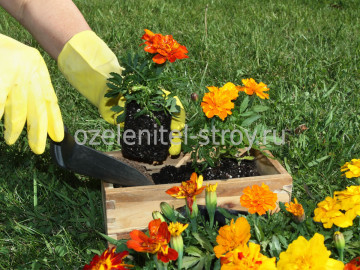 Still, expect it only in the second year.
Still, expect it only in the second year.
Most biennials begin to be sown in late June and early July in greenhouses. It is also possible to plant flowers in open ground. In hot weather, plants are shaded, watered, weeded, and fed if necessary. From the end of August to the end of September, biennials are planted in a permanent place at a distance of 10 -20 cm from each other. For the winter they are covered with spruce branches. On next year caring for them comes down to regular watering, weeding, and fertilizing with nitrogen fertilizers.
Planting perennial flowers
Unlike annuals and biennials, perennial flowers grow in one place for several years. Grow them different ways: seeds, bulbs, cuttings, dividing the bush and root. The best time to plant perennial flowers is early spring and the period from late August to September. 
Seeds of perennials are usually planted before winter. They usually bloom in the second or third year after sowing. But there are exceptions - delphinium, for example, although not very profusely, will bloom in the first year. Perennials are usually sown in October in slightly frozen ground. The soil should be loose, well fertilized and light. In spring, seedlings peak.
Vegetative planting of flowers is carried out by cuttings of rhizomes, stem or leaf cuttings, layering, and dividing the bush. First, the plants are allowed to take root and then planted in a permanent place.
Bulbous flowers that bloom in spring (tulips, daffodils, crocuses) are planted in autumn. Summer flowering flowers (gladioli, cyclamen) are planted in the summer. Lilies can be planted in both spring and autumn. Heat-loving bulbous plants(gladioli, callas, dahlias) are dug up for the winter and stored until 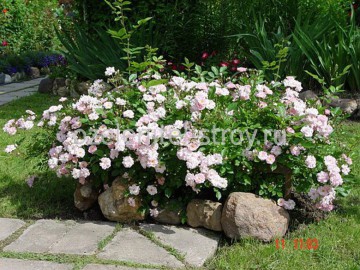 early spring.
early spring.
When planting flowers, you should take into account the fact that perennials grow greatly over time, so it should be fairly loose. To avoid the impression of excessive sparseness, in the first year of planting flowers, annuals can be planted between perennials.
The specialists of the Ozelenitel Stroy company will help you make your garden truly beautiful and elegant. We will select varieties and types of flowers according to your tastes and preferences and carry out high-quality and professional planting of flowers.
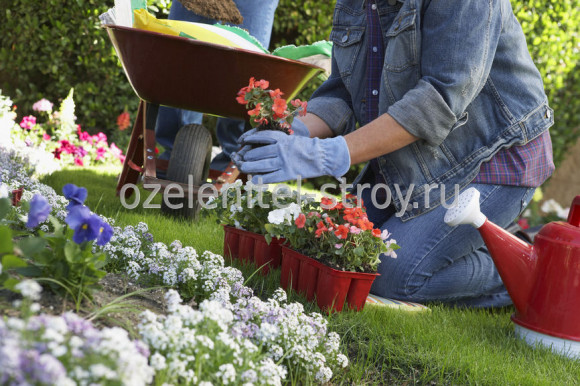
It’s always nice when, upon arriving at your dacha or going out into your yard, country house, we are surrounded by colorful picturesque greenery. At such moments, any artist takes brushes and paints and paints his next masterpiece. For a summer resident, in addition to the fact that he can capture this beauty with a camera or simply admire and enjoy the aroma of the fragrant blooming garden It’s also worth thinking about how to preserve and increase this beauty in subsequent years.
As soon as the snow melts, in the spring summer cottages, flower growers wait with bated breath for the first flowers to appear. After all, after a long winter, spring colors are a real decoration on the site.
In this material we will not dwell on any specific garden flower, but we will offer you a mini-instruction in which we will tell you what flowers are planted in the spring and when to plant them according to the timing.
Most often, garden flowers need to be planted in late August - early September. This is the best time for plants to take root for our strip. And only certain types flower plants can be plant exactly in spring period time. Both in spring and in other seasons, planting new flowers is done in the following possible ways:
- Sowing seeds
- Seedlings
- Dividing perennials
- Cuttings of perennials
Planting spring flowers with seedlings
Enough a large number of types of garden flowers can be planted in spring as seedlings. These include: Ageratum, Balsam, Begonia, Verbena, Viola, Gazania, Heliotrope, Helichrysum, Dahlia, Morning Glory, Calceolaria, Cleome, Kobeya, Levkoy, Limonium, Matricaria, Nasturtium, Purslane, Thunbergia, Phlox annual, Celosia and a number of others .
Marigold
This annual plant, having double flowers orange, yellowish-golden, red colors. They bloom from early June until frost. Planting of marigolds is done by growing seedlings (you need to sow the seeds in early April) or directly into the ground with seeds, at the very beginning of May in already sufficiently warmed ground.
Marigold seeds need to be soaked and sown in a box with prepared soil. The seeds are lightly sprinkled with soil. Shoots appear after 1 week, they are thinned out when they already have 2-3 leaves. From the end of May, when frosts stop, seedlings can be transplanted into open ground at a distance of 15-30 centimeters from each other. When transplanted, they take root well.

Turkish cloves
This biennial plant blooms almost all summer - from June to September. Propagated by sowing seedlings (in April) or directly into the ground with seeds (before winter or in early spring). Grow in partial shade or sun. Requires loosening of the soil.
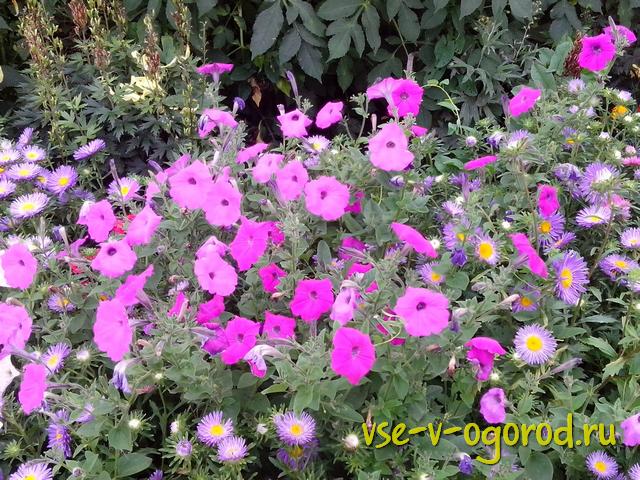
Petunia
More details about petunia and its care are written in one of our articles. Petunia seeds are sown for seedlings already in February-March, sprinkled on the soil, mixed with sand, and gently pressed down with your hand. The container for sowing is covered with glass or plastic film and bet on sunny place in the room. Picking of seedlings is carried out when 3-4 leaves appear. Petunia seedlings are planted in a permanent location at the end of May. She is not afraid of transplantation, as she root system recovers quickly.
Planting spring flowers with seeds
By planting seeds in spring, you can grow a huge amount of different types both annual and perennial garden flowers. So, in spring, with the help of seeds you can grow: Adonis summer, Aquilegia, Acroclinum, Anhusa, Arctotis, Perennial Asters, Bartonia, Marigolds, Cornflowers, Venidium, Bindweed tricolor, Annual Gaillardia, Chinese Carnation, Annual Hibiscus, Gypsophila, Annual Delphinium, Dimorphotheca, Sweet pea, Iberis, Kentranthus, Coreopsis, Lavatera, Toadflax, Monarda, Nasturtium, Nemisia, Nemophila, Nigella, Platycodon, Primula, Feverfew, Mignonette, Chamomile, Rudbeckia annual, Skerda, Tar, Dream-grass, Ursinia, Chrysanthemum, Zinnia and many other.

Calendula
Calendula is sowed in April-May directly into the ground, right on the site of the flower bed. Calendula blooms from June until frost. Prefers sun rays; any soil is suitable, except dry or excessively wet. Can be grown on balconies, flower beds, terraces, as well as in separate containers.
Lupine
Lupine blooms from June to July, and again from August to September. The plant is planted with seeds in April-May. Please note that the height mature plant reaches 1 meter. Required sun rays and acidified soil. Combines with herbaceous perennials.
Dream-grass
In nature, sleep grass grows in steppe meadows and open glades. In order to grow dream grass in your garden, you should get its seeds.
Sleeping grass seeds should be sown in already well-warmed soil in the spring, around mid-to-late April, since the suitable temperature for their germination is between 20-25°C. The soil must be well-drained; therefore, a certain amount of peat, sand and mineral fertilizer should be added.
Primrose
Primroses take root well at near-zero temperatures, so best time for planting primrose - immediately after the snow cover melts, but if you provide them constant watering, then they will undergo division and transplantation at any time. Primrose requires partial shade with rich loam, constant feeding, and no wetting or drying out.
Planting spring flowers by division
Many flowers in the garden are perennial and live indefinitely or for several years. If you want to increase your existing plantings of these flowers, you can resort to the method of dividing an adult plant. For example, the following flora representatives are quite suitable for division: Arunkus, Astilbe, Perennial Astra, Helenium, Hemerocalis, Goldenrod, Euphorbia, Monarda, Pyrethrum, Phlox, Chrysanthemum and some others.
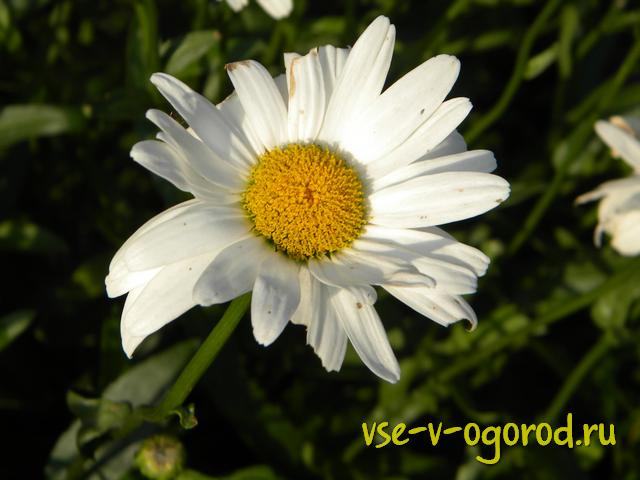
Pyrethrum
In the spring, young shoots of Pyrethrum need to be transplanted to a new place. At the beginning of the summer season, you can cut green cuttings and in twenty days they will have time to take root.
Planting spring flowers by cuttings
Many perennial flowers can be easily propagated using cuttings. This includes plants such as: Aquilegia, Astilbe, Carnation, Delphinium, Derbennik, Nivianik, Catnip, Petunia, Pyrethrum, Sage, and others.
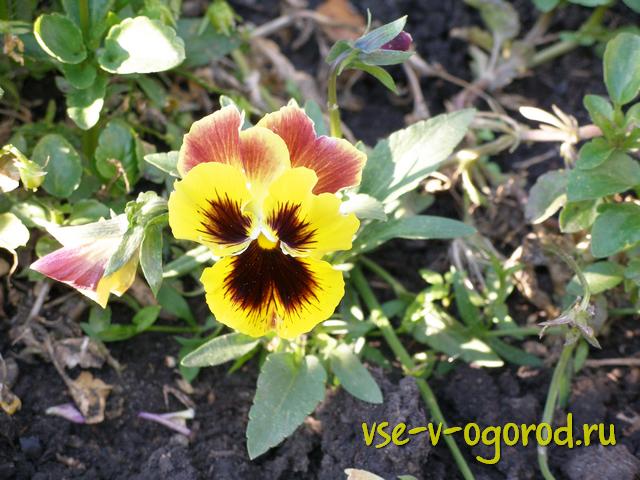
Cuttings in open ground - simple and easy way propagation of this plant. In this way you can get a sufficient amount planting material. It is better to spend it in May. To do this, the terminal green shoots with two or three nodes are cut from the bushes. The cuttings are planted in a shaded place close to each other to a depth of half a centimeter. After this, the cuttings need to be watered. After a month, the violet cuttings begin to develop roots.
Versatile spring flowers
By universal spring flowers we mean those types of plants that can be planted in the spring in the most different ways- using seeds, cuttings and division. They can also include the previously listed types of spring sowing flowers.

Aquilegia
Aquilegia blooms from May to August. Aquilegia is planted in the spring in April-May, or in early autumn, in September. It should be grown in partial shade on moist soil.
Daisies
Daisies are planted in the first weeks of May. They begin to bloom at the same time, since the plant is experiencing quite well winter period under the snow. However, in cooler areas they should be covered for the winter.
And this is only a small part of the plants that you can use to decorate your garden, propagating them in spring days.
Alekseyuk E.F. | 2015-02-14
Perennials, growing for a number of years in one place, form a powerful bush that can be divided into several independent bushes. If the bush is not divided or dug up, then over many years the soil around it becomes compacted, the rhizome ages, the plant weakens and stops developing, and flowering decreases.
When dividing, the plant rejuvenates and causes increased vital activity. After planting in fresh soil, shoots and root systems begin to develop intensively. But there are perennials that react painfully to division and feel better if they are not divided or replanted for a long time. Such plants include peonies, poppies, incarvillea, dictamnus, and roses. In this matter it is necessary individual approach for each species or variety.
What flowers to divide in spring?
In spring, perennials should be divided blooming in autumn, - phlox, asters, heleniums, goldenrod, rudbeckia, and this must be done as early as possible, and the work must be completed before mid-May.
Depending on the power of the bush, it is divided into several parts, but so that there are 3-5 buds per division, a root lobe and part of the rhizome. With this division, many types of perennials begin to bloom in the first year, and bloom profusely in the second.
Division must be carried out sharp knife, digging up the entire bush, but you can separate a section without digging up the bush completely; in this case, the soil is raked away from the bush, exposing the rhizome, and the section is cut off, then the cut area is sprinkled with crushed coal or ash.
All divisions are also disinfected, allowed to dry and planted in a prepared place. The cuttings are planted in the ground so that the renewal buds are at a depth of 3–5 cm. Then all plantings are watered abundantly and mulched on top with peat, humus or dry soil.
Of course, a place to plant perennials better to cook in the fall. Dig to a depth of 25–30 cm, remove all weed roots, fill with humus and mineral fertilizers. Heavy clay soils lime by adding lime 100–150 g/m2. Add clay and well-decomposed peat to sandy soils to create a better structure. If this work was not carried out in the fall, then it can be done now.
The most important thing is the right choice of site
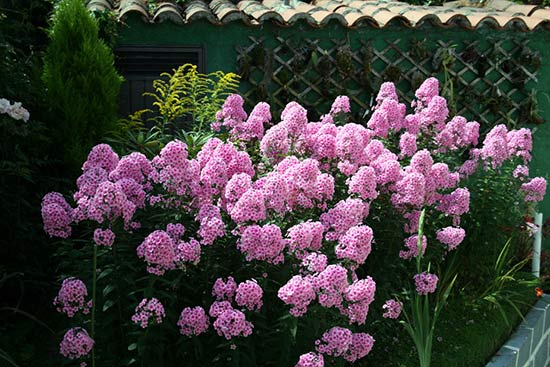
The most important thing for planting perennials is choosing a site. Places flooded for a long time with spring or rainwater, as well as with close occurrence groundwater completely unsuitable for planting perennials. Here they die from getting wet and freezing.
If possible, it is necessary to select areas protected from the prevailing winds in order to protect the plants from damage. Flower plants grow best in medium to light loams with good solar lighting. Most plants require a lot of heat and light, and only a few tolerate partial shade or shade.
When propagating perennial flowers vegetatively young plant completely retains all the decorative qualities of the mother plant, but at the same time, all the diseases that it suffers from are transmitted. Therefore, you should choose a mother plant that is strong and healthy.
Perennials with taproot It’s better not to divide or replant at all, they will hurt for a long time and may not take root at all (poppy, lupine, gypsophila). They are best grown from seeds, which should be immediately sown in the ground in a permanent place.
Small-flowered chrysanthemums should also be divided in the spring, both by cuttings and by dividing the bush. Root shoots or young side shoots growing on old stems are taken as cuttings. Cuttings 5–7 cm long are planted in boxes or pots with nutritious soil or sand, moistened and covered with glass or film. The cuttings take root very quickly and well.
Dividing the bush. Well-grown root shoots are dug up along with the remains of the old bush and young shoots with roots are separated. Rooted cuttings and divisions are planted in open ground when the danger of spring frosts has passed. Chrysanthemums are very light-loving plants, and they should be planted in the brightest place at moderate temperatures. damp places.
How helpful is this page?